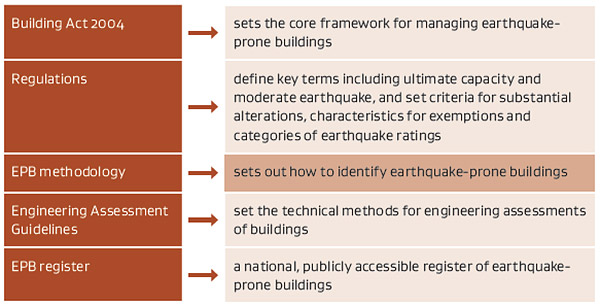Introduction, references and definitions
This methodology is set by the Chief Executive of the Ministry of Business, Innovation and Employment under section 133AV of the Building Act 2004.
Introduction
This methodology is for the identification of earthquake-prone buildings, which are defined in section 133AB of the Building Act 2004.
This methodology is a disallowable instrument under section 38 of the Legislation Act 2012.
This methodology is part of the system for managing earthquake-prone buildings.
The structure of the system is shown in Figure 1.
Figure 1: The structure of the system for managing earthquake-prone buildings

Referenced document
This methodology refers to the following document:
- The Seismic Assessment of Existing Buildings: Technical Guidelines for Engineering Assessments, July 2017, Version 1, referred to as the Engineering Assessment Guidelines within this methodology.
and its sections:
- Part A Assessment Objectives and Principles; referred to as Part A within this methodology
- Part B Initial Seismic Assessment; referred to as Part B within this methodology
- Part C Detailed Seismic Assessment; referred to as Part C within this methodology.
The Engineering Assessment Guidelines are available from the building.govt.nz website.
Definitions
Building Act 2004 (Building Act)
Is the principal legislation dealing with building controls in New Zealand.
Commencement
Is the date that Subpart 6A of Part 2 of the Building Act 2004, and associated amendments to other sections, came into force.
Critical Structural Weakness
Is the lowest scoring structural weakness determined from a Detailed Seismic Assessment meeting the requirements of Part C of the Engineering Assessment Guidelines. For an Initial Seismic Assessment meeting the requirements of Part B of the Engineering Assessment Guidelines, all structural weaknesses are considered to be potential Critical Structural Weaknesses.
Detailed Engineering Evaluation
An assessment carried out to evaluate buildings following the 2010-2011 Canterbury earthquake sequence. It was only intended for use following an earthquake that causes damage to buildings and is now called a Detailed Damage Evaluation.
Detailed Seismic Assessment
A seismic assessment carried out in accordance with Part C of the Engineering Assessment Guidelines. It is a comprehensive quantitative assessment of the strength and deformation capability of a building.
Earthquake rating
Has the meaning defined in section 133AC of the Building Act 2004.
Engineering assessment
Has the meaning defined in section 7 of the Building Act 2004.
High seismic risk
Has the meaning defined in section 133AD of the Building Act 2004.
Initial Evaluation Procedure
The quantitative steps that are part of the Initial Seismic Assessment process.
Initial Seismic Assessment
A seismic assessment carried out in accordance with Part B of the Engineering Assessment Guidelines. It is the recommended first qualitative step in a Detailed Seismic Assessment.
Low seismic risk
Has the meaning defined in section 133AD of the Building Act 2004.
Medium seismic risk
Has the meaning defined in section 133AD of the Building Act 2004.
Mode of failure and physical consequence
Is the manner and extent to which any element scoring less than 34%NBS could collapse or fail and its physical consequence. There may more than one mode of failure and physical consequence.
Moderate earthquake
Has the meaning defined in the Building (Specified Systems, Change the Use, and Earthquake-prone Buildings) Regulations 2005 (as amended).
Owner
Has the meaning defined in section 7 of the Building Act 2004.
Previous assessment
An assessment carried out by an engineer before commencement of Subpart 6A of Part 2 of the Building Act 2004. A previous assessment may have been commissioned by a territorial authority or an owner.
Territorial authority
Has the meaning defined in section 7 of the Building Act 2004.
This methodology
The EPB methodology, which has the meaning defined in section 7 of the Building Act 2004.
Ultimate capacity
Has the meaning defined in the Building (Specified Systems, Change the Use, and Earthquake-prone Buildings) Regulations 2005 (as amended).
%NBS
The rating given to a building as a whole expressed as a percent of new building standard achieved, based on an assessment of the expected seismic performance of an existing building relative to the minimum that would apply under the Building Code (Schedule 1 to the Building Regulations 1992) to a new building on the same site with respect to life safety.
A score for an individual building element is also expressed as a percent of new building standard achieved. This is expected to reflect the degree to which the individual element is expected to perform in earthquake shaking compared with the minimum performance prescribed for the element in Clause B1 of the Building Code (Schedule 1 to the Building Regulations 1992) with respect to life safety.
The %NBS rating for the building as a whole takes account of, and may be governed by, the scores for individual building elements.